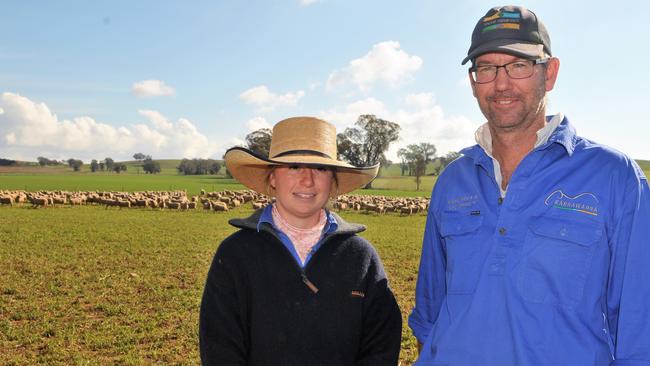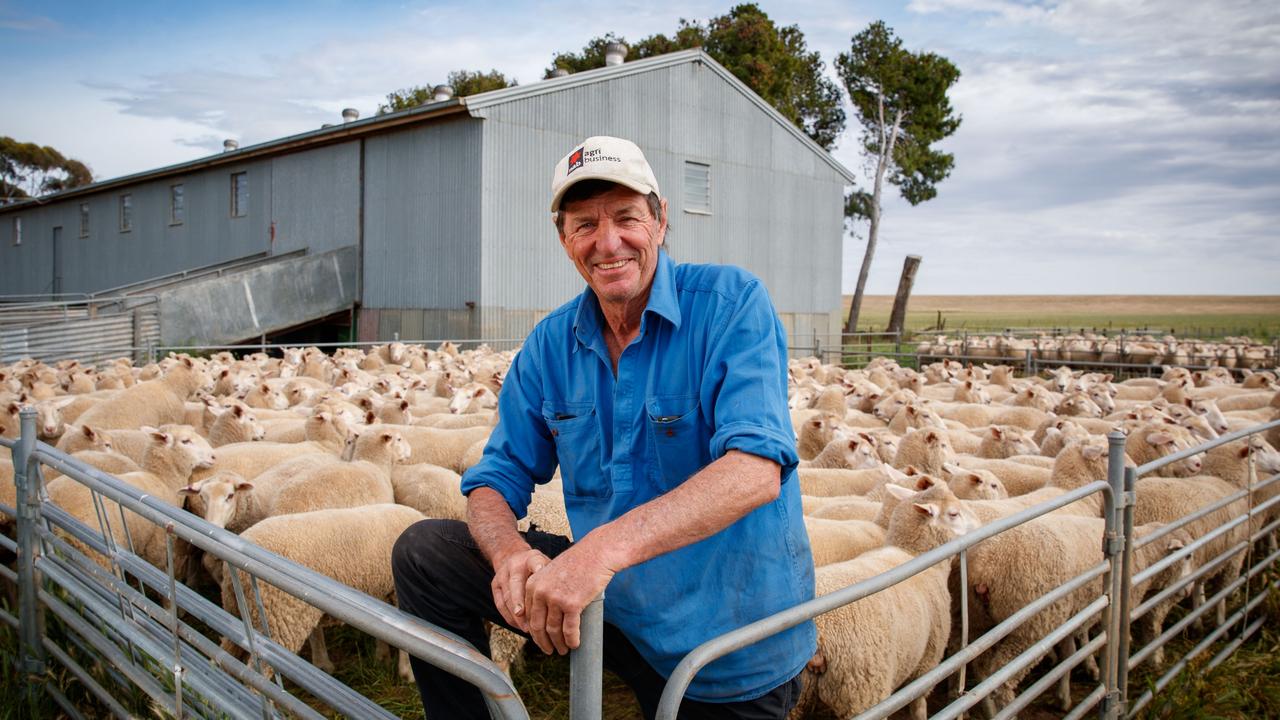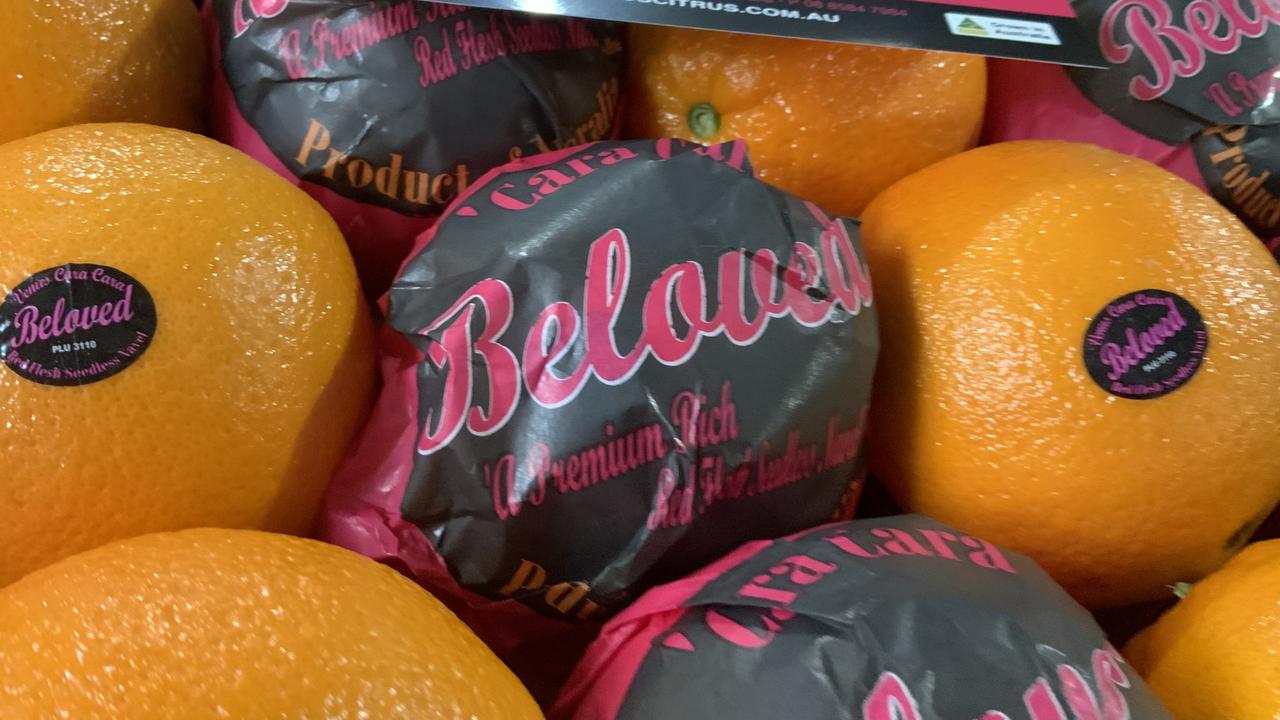Highlander fling proves to be game-changer
A switch to Highlanders has taken this prime lamb business to a whole new level.

FOR Leo and Vanessa Herbert, it was a move that made not just dollars but sense.
Five years ago, the mixed farmers from Wantabadgery, in the rolling hills northeast of Wagga Wagga in the NSW Riverina, found themselves at a crossroads with their prime lamb business. Running Dorpers at the time, and keen to switch to a self-replacing maternal flock with a terminal sire to produce sale lambs, Leo fired up his computer.
“I jumped on the internet and began looking for terminal breeds that boasted low birthweights and were early maturing,” Leo said, adding that his search engine took him across the ditch to New Zealand and the Focus Prime, a finely tuned composite breed developed by one of New Zealand’s biggest landholders.
Focus Genetics is a subsidiary of the NZ Government-owned Landcorp Farming Limited and develops genetics for its expansive beef, sheep and deer operations that cover more 375,000ha spread across more than 120 farms.
Impressed by their prospects, Leo purchased six Prime rams from a Victorian farmer that were part of an original consignment of Focus rams imported from New Zealand. He said their performance exceeded all expectations, leading to them to inquire as to “what else (Focus) had in their kit bag”.
It was then the Herberts were introduced to the maternal Highlander breed and approached about becoming a breeding partner for Australia. Focus has similar arrangement with breeders in Uruguay and the UK.
“Being a stud breeder wasn’t high on my list of things I wanted to do, but the only way I could get the genetics I wanted was to become one,” Leo said. “So the stud is there to complement the commercial business really.”
In the first year of using Highlanders, the Herberts increased their ewe scanning rates from 120 per cent of lambs to 140 per cent. “Now we’re doing 180s,” he said. “It is not hard to do the figures, 10 per cent (a year) over 8000 ewes is another 800 lambs and at 200 bucks there’s another $160,000 in your pocket. It’s pretty simple if you get the right genetics. That was the main driving focus.”
The Herberts’ Karrawarra Pastoral business is now home to one of Australia’s biggest Highlander flock and the stud, under the management of Hannah Anderson, sells 350-400 rams a year across Australia.
STRONG FOUNDATIONS
LEO is a fourth-generation farmer in the district. His father, Mike, started with 162ha and slowly built on it to 1200ha. Leo took over in 2000 with 607ha and grown it to 4455ha — 2430ha of their own land and 2025ha of leased country.
The business is spread over several blocks all within about 50km of each other at Wantabadgery, Eurongilly, Bethungra and Mundarlo.
The farms range from red loam to hilly scrub and boast an average annual rainfall of 580-600mm.
Leo described this season as remarkable following a tough few years.
“It was the best autumn we’ve had for a long while,” he said. “2016 would be the biggest year we’ve had — it was good everywhere — but this was one of the better autumns we’ve had, that’s for sure.”
About 60mm of rain in March allowed for the early sowing crops and now “we’ve got more feed than we can handle”. The Herberts grow canola, wheat, barley and lupins in addition to forage crops. This year they have about 1600ha of crops sown, 1200ha of which will be harvested and 405ha of pasture sprayed out.
Sheep are the core business and the Herberts currently run 8500 ewes – comprising 1200 stud and 6800 commercial ewes. The aim is to increase stud numbers to about 1500 and commercial ewes to 8500.
Leo said he placed high selection pressure on the three pillars of adult bodyweight, fertility and survivability, with more than 90 per cent of foetuses making it through to weaning.
On the bodyweight front the Herberts target a 65kg ewe, citing bigger ewes as becoming a problem for the industry from an inefficiency and handling perspective. Leo said Highlanders grew rapidly until seven to 10 months when they “flatten out seriously”.
TOP PERFORMERS
ALL stud ewes are derived from 1800 embryos imported from New Zealand four years ago that were in the top 2 per cent of the nation’s stud flocks.
The stud uses a mix of natural matings and artificial insemination. This year they didn’t use any of their own sires in the AI program, instead using semen from Australian Meat rams to create linkage into the Sheep Genetics Australia database. Highlanders have been recorded on New Zealand’s Sheep Improvement Limited database for 30 years but have only just started to be measured on Sheep Genetics.
Joining takes place in February and runs for about five weeks. Seven to eight-month-old ewe lambs are joined slightly later for four weeks.
Leo says this year the ewe lambs were joined at the same time as the remainder of the ewes, followed by a break before terminal rams were put in “to pick up what wasn’t joined early”. The offspring from the later joining will be sold as terminal lambs.
Karrawarra works on ram-to-ewe joining rates of about 1.5 per cent in mobs of 70-75. This year the stud ewes were all single-sire mated in mobs of 50 with no back-up rams.
All ewes are scanned 42 days after the rams come out. In an attempt to pick up more triplets this year Karrawarra scanned at 38 days for a result of 179 per cent in lamb. Only 2.6 per cent of ewes, including hoggets, didn’t get in lamb. Dry ewes are culled while those bearing multiple lambs are managed with feed accordingly.
Grazing paddocks range from 120ha to 360ha with improved pasture paddocks generally 40ha. At Wantabadgery, where the bulk of the cropping enterprise is, pastures are lucerne-based with clover and chicory.
WINTER WONDER
LAMBING starts in the first week of July with mature commercial ewes followed by mature stud ewes and the remainder of the flock. Lambing takes place on 1620ha of natural hills of red grass and clover that provide ewes and lambs with a drier environment as well as shelter such as trees and rocks.
“I’m not a big fan of lambing down on the flats. We do it, but if you get a good year with clover and lucerne and the ewes have got twins in them they can get too big and heavy and too many things can go wrong. If they get up in the hills, they get fit and walk around.”
The farms’ feed gap is in September. That’s when, as Hannah puts it, “we get jammed up and we have to lock up crops and shoehorn everything on to leftover lucerne and hills”.
“You’re hanging out for stubbles and your numbers have doubled because they all have lambs on them,” she said.
Weaning takes place in October. From this year’s scanning results the Herberts are banking on weaning percentages in the mid-160s.
All ewe lambs sired by Highlanders are retained or given a light cull. “Obviously structure is No. 1, but we also like them to have a black nose, black points, black feet.” Leo said ewes weren’t culled on age and could be used for six or seven years, or seven or eight lambings.
In the terminal flock, the best 300 or so lambs — “anything that is at the lead of the mob” — are sold through the Wagga Wagga saleyards with the bulk sold direct to Coles.
The best lambs reach the target 22kg carcass weight within 16 weeks. Due to bone development, the earlier lambs yield 52 per cent meat while the older ones taper off to 48 per cent, meaning “you’ve got to adjust your weight accordingly”. The aim is to have all lambs off the farms by 20 weeks of age.
TOP CHOPS
THE Highlanders are not known for their wool production. At Karrawarra, the sheep are shorn annually and produce about 4kg of wool, which averages 31-32 micron.
The stud conducts two ram sales a year — one for ram lambs in February and the other for one-year-old lambs in the spring. This year’s spring sale will be conducted on September 22.
Karrawarra has a good client following in central and southern tablelands of NSW, as well as Western Australia, Tasmania, southwest Victoria, South Australia and Queensland. Clients range from family operations that purchase one or two rams a year to corporates that might take 10-30.
Hannah, who previously worked for the Focus Genetics business, said the Highlanders were pretty adaptable but probably best suited to higher-rainfall environments.
“You can run them pretty hard,” she said. “In New Zealand, they run on very steep slopes. People think there’s so much feed in New Zealand but there’s really not, especially in winter they get no growth and they’re standing on the side of the hill — they look like rakes when they come down and they’ve got two big lambs hanging off them.”
Long term, Leo said there was good demand for lamb and red meat more broadly, despite the effects of coronavirus on the world economy.
“Lamb prices have been pretty good. Anything around that $8-$9/kg mark — if you can’t make money out of that there’s something wrong,” he said.
“I can’t see it changing dranatically anytime soon — even cattle, the red-meat job is a pretty good commodity to be involved in.”
MORE
VERTICALLY INTEGRATED LITTLE BIG DAIRY



